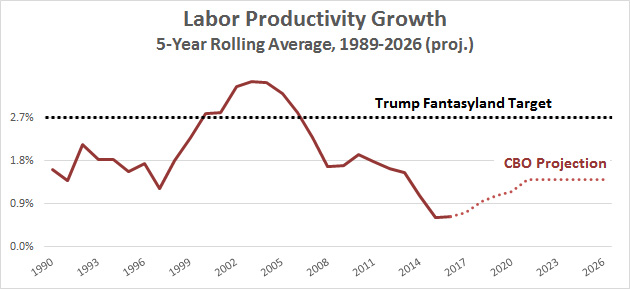The Congressional Budget Office forecasts that the labor force will grow 0.5 percent annually over the next ten years and productivity will grow 1.4 percent. That’s total economic growth of 1.9 percent per year. But the Trumpists are forecasting 3.5 percent growth over the next decade. Let’s give them the benefit of the doubt and assume that they supercharge the economy, pulling everyone back into work and achieving labor force growth of 0.8 percent. They still need productivity growth of 2.7 percent. That’s astronomically higher than anyone thinks possible. So how are Trump’s economists justifying this?
The answer is simplicity itself. The Wall Street Journal explains:
What’s unusual about the administration’s forecasts isn’t just their relative optimism but also the process by which they were derived. Normally, the executive branch starts with a baseline forecast prepared by career staff of the CEA….Discussions for the Trump administration unfolded differently, with transition officials telling the CEA staff the growth targets that their budget would produce and asking them to backfill other estimates off those figures.
So…they’re doing it by just telling their economists what growth will be. That’s an interesting approach. But what’s the point of this? Here’s a pair of growth forecasts—one for 2 percent and one for 4 percent—that should illustrate things:

If you assume higher growth, you can cut taxes and still get more revenue. Alternatively, you can spend more on the military or a border wall without increasing the deficit. Or a combination of both.
In other words, it’s magic fairy dust. Sprinkle it around and you can do anything you want. Problems only arise if a bunch of snooty Ivy League economists insist that you’re delusional, which explains why Trump hasn’t bothered to hire anyone for his Council of Economic Advisors. They would just tell him stuff he doesn’t want to hear. It also explains why Paul Ryan isn’t playing this game too: his budget is vetted by the CBO, which has no intention of aiding and abetting fantasyland figures like these.

It’s hard to know what the point of this is. Most likely, Trump said on the campaign trail that he’d grow the economy at 4 percent, and by God he’s going to stick with that. (Remember: 3.5 rounds up to 4, so his campaign promise is safe.) Besides, Trump probably really believes that he can get the economy growing that fast through the sheer force of his personality.
The real shock here isn’t Trump—we already know he’s divorced from reality—but the rest of his staff. Is there really not a single person in the White House who has both the gumption and the standing to tell Trump that the president can’t peddle this kind of drivel in an official document? Is there no one who can tell him that Twitter is one thing, but the Budget of the United States of America is another?
I guess not.
UPDATE: The original illustration of 2 percent vs. 4 percent growth used figures for nine years of growth instead of ten. It’s been corrected.


















